This blog follows on from my blog last week, describing our research into the issues facing town centres in the North East, and our findings following the roundtables we held in Newcastle, Middlesbrough, Hexham, Berwick-upon-Tweed and Stanley. In this second instalment, I look at the recommendations coming out of our work with the North-East England Chamber of Commerce (NEECC), and the need for a holistic approach in making our centres fit for the twenty-first century.
There is no ‘one size fits all’ approach to ‘saving’ the high street. If there was, then we would have cracked the problem long before now.
Each and every town centre is different. That goes as much for the approach of traders towards engaging with other stakeholders as it does to the retail offer and shopping environment provided. Whilst the Business Improvement Districts (BID) in Newcastle-upon-Tyne has racked up some impressive achievements – increasing average spend by 16% in a three-year period – that in Hexham (in nearby Northumberland) has ended up in relative acrimony. Their success can only be achieved through effective collaboration but, as my colleague Summer Haly has highlighted in
her own blog, they can play a significant role in generating economic growth. With the views from the roundtables held in these and three other town centres (Hexham, Berwick and Stanley) at the forefront of our minds, our joint (NEECC/Lichfields) report provides recommendations in four key areas.
1. Creating a vision
The single-most important objective should be to create a vision of what town centres should look like and offer to visitors - enshrining this in a strategy, with a set of short, medium and long-term actions. One or more Unique Selling Points (USP) should be developed as part of this vision, and then promoted along with every aspect of the centre. This includes the retail and leisure offer, other things to do/places of interest and how to get there (not forgetting where to park…). The coastline in Northumberland is stunning, but how many tourists actually consider visiting Berwick upon Tweed Town Centre, or even know where it is? Not many, apparently – but surely, this is a missed opportunity?
2. Broadening the offer
Of all the attention paid to town centres over the last year or so, probably the biggest theme has been the shift away from retail. This is not as easy to solve as it sounds, given that the food and drink sector has shown signs of saturation in some locations. That said, smaller centres still have some catching-up to do, particularly those with an evening economy focused towards alcohol – and ‘family friendly’ is the watchword here. To its credit, the Government is alive to the need for more flexibility, as shown by a succession of amendments to the permitted development rights (PDRs) regime, and further PDRs proposals included in a consultation currently underway. But local authorities must also think about what new (non-retail) ‘anchors’ they can attract, in order to keep people coming in.
3. Taking a pro-active and holistic approach
Environmental improvements alone won’t solve all town centres’ problems but they do help. Getting the basics right means keeping the centre clean and tidy, safe, attractive and easy to navigate. To see these improvements, though, people need to be drawn in on a regular basis, and a well-curated programme of events can play a part, reinforcing the centre’s role as a civic heart. New residential development and student accommodation (in the right locations) also help to generate additional footfall and spending in existing facilities. They are not Main Town Centre Uses in planning speak but bring a range of benefits.
4. Business leading the way
They might not want to hear this, but retailers could do more to secure their future – by reinvigorating their offer and the customer experience, for example. Independents, however, also need better support from local authorities in order to thrive. Perhaps more than national multiples, the more tailored-service independent traders typically offer gives them a decent chance of bucking recent trends towards use of the internet and out-of-centre retail parks, but to do this they need help and advice (the ones we met in Stanley, County Durham, certainly felt so). As I suggested in my previous blog, they need to embrace the internet, develop and promote their online offer, and promote delivery and click-and-collect services where they can.
Final thoughts
We cannot look at these issues through rose-tinted glasses. The economic circumstances of individual areas, particularly in the North-East, mean that some centres will inevitably contract and their importance diminish. But is it worth investing in our town centres? Certainly it is. Although their social role is perhaps even more important, the economic benefits of a thriving town centre far outweigh the short-term costs in, for example, creating an effective centre management function or creating a prospectus for investment (as Middlesbrough Council has done).
What is the right approach for one centre may be wrong for another. Our recommendations could be seen as a shopping list (excuse the pun) for town centre stakeholders to pick from. Neglecting one area at the expense of others, however, is unlikely to reap the same rewards. In an age when social media and instant information rule, it is not enough having the right offer if no-one knows about it. Having met people from all parts of the North-East, I’m confident we can re-establish our centres at the heart of the community. Where there is a will, there is a way.




